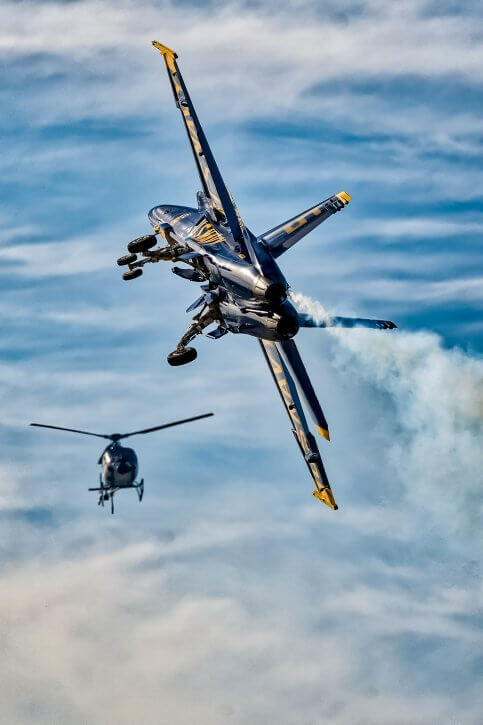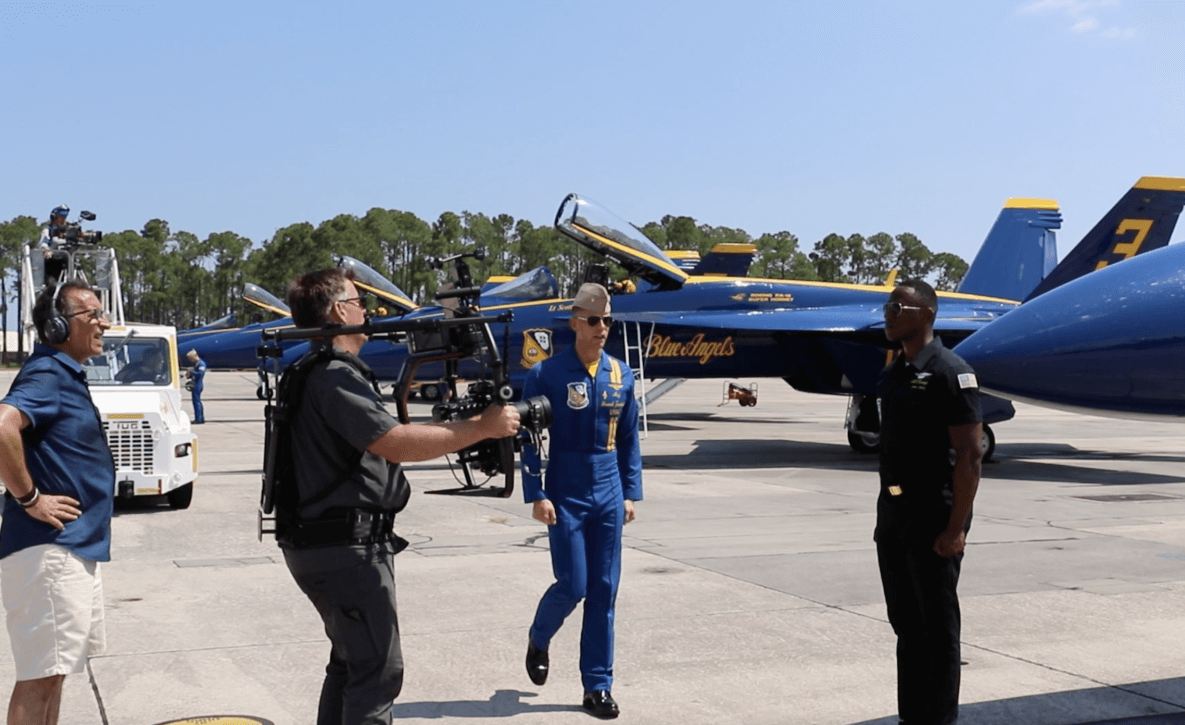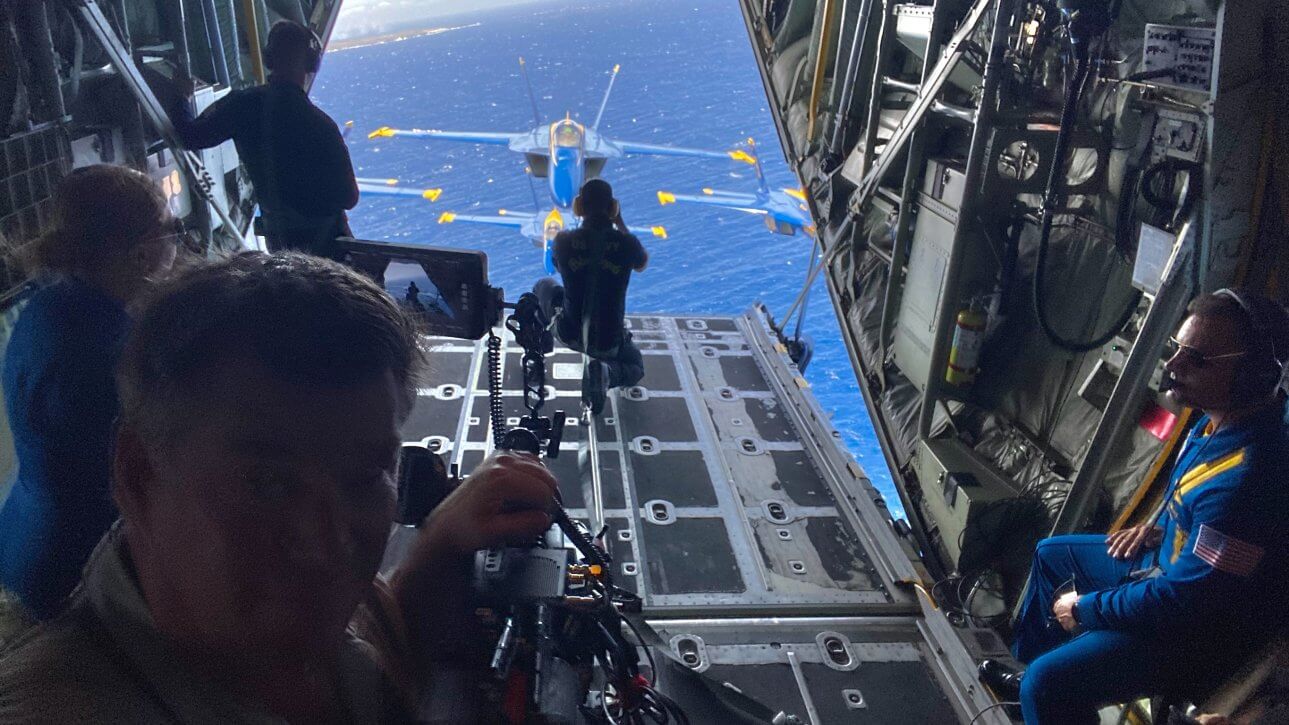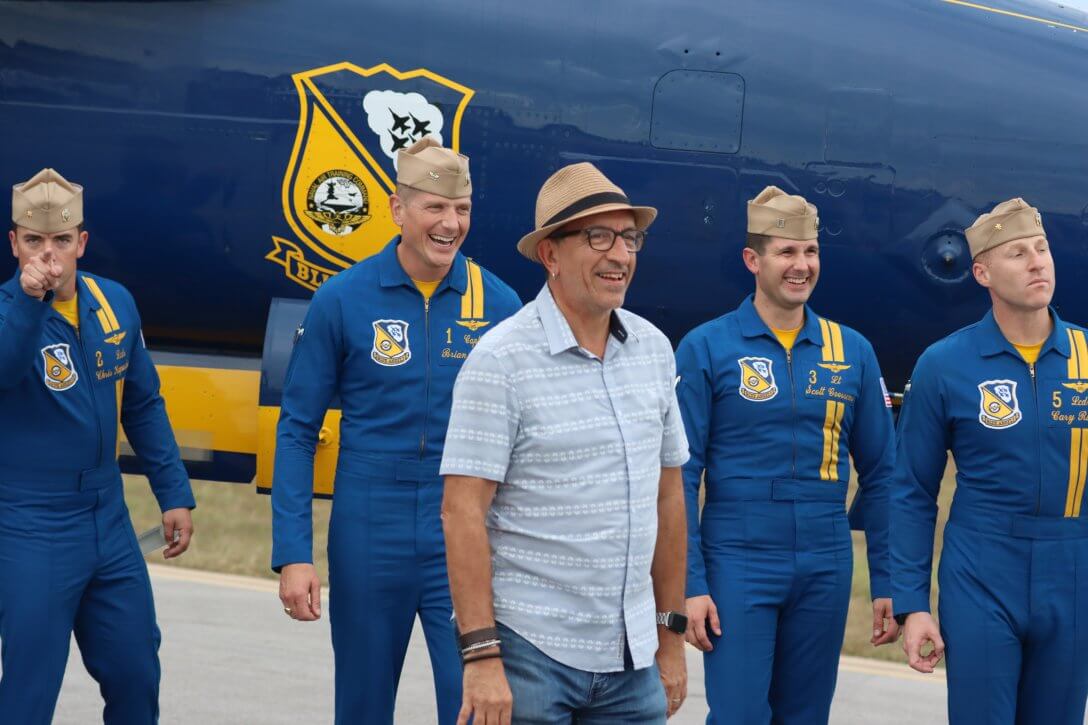Director Paul Crowder Discusses New IMAX Documentary

People worldwide love and admire the U.S. Navy’s Blue Angels, but locals have a unique appreciation for the talented demonstration flight team that calls Pensacola home. Known for their gravity-defying aerobatic flight skills and their unparalleled excellence, a Blue Angels Air Show creates a sense of magic, wonder and patriotism for all who attend. Blues fans will soon have the chance to experience the adrenaline-fueled world of Naval aviation like never before as acclaimed director Paul Crowder takes viewers on an exhilarating journey in his latest documentary, The Blue Angels. Filmed for IMAX, the immersive footage puts viewers in the cockpit for a firsthand view of the Blues’ precision flying while the aerial shots deliver a spectacular showcase of the breathtaking maneuvers that have made them the world’s premier jet team. The Blue Angels also takes audiences behind the scenes for a revealing, in-depth look at what it takes to become a Blue Angel. Pensacola Magazine had the pleasure of speaking with director Paul Crowder about the film, the flight team and his newfound love for Pensacola. Fans can experience The Blue Angels in IMAX theaters for one week only, May 17 – 23, and streaming globally on Prime Video beginning May 23.
Whose idea was The Blue Angels documentary and how did you become involved?
The concept was Capt. Greg Wooldridge, I believe. He was the most infamous boss of the Blue Angels. He was the only Blue Angel to be a boss three times. He had made a film with a guy called Rob Stone back in the 90s called Blue Angels: Around the World at the Speed of Sound. They decided they wanted to do a 75th anniversary film, so they started pitching it when it was the 74th year, not realizing how long it might take to get it together. They got Glen Powell attached. I think Glen Powell got Bad Robot attached and Bad Robot then went to Glen Zipper and Sutter Road. We had just finished the UFO show that we did for them for Showtime. We had such a good experience on that show, and they asked if we wanted to do the Blue Angels film. I was a little surprised because I hadn’t shot aviation before. I knew of the Blue Angels, of course. I used to see the Red Arrows in England, which is sort of the British version. We just dove straight in. We met with Boss Greg and Rob Stone, and we went down to the show in Huntington Beach. We met the team at the time, plus the newbies that were joining up—which ended up being the guys on the team when we got there to shoot. It started from there.
I understand this film is focused on the process of becoming a Blue Angel. What did you learn about that process that stood out to you?
I think the most fascinating thing, of course, is that they turn over a third of the crew each season. It’s not just the six pilots, it’s a crew of roughly 150 personnel. They had to train a third of the team in three months before the first show. We had the same boss (Capt. Brian Kesselring), but he had a new number two and a new number three. Number three moved to four, but he hadn’t flown four before. Number six went to five, but Chewy (Lt. Cmdr. Cary “Chewy” Rickoff) had been injured the season before so he hadn’t flown much anyway. So, it was almost four new guys. That was just fascinating to me that these guys that are going to be flying this demonstration hadn’t flown with this team before. The first practice was in late December, and they had to be ready to do a show in the second week of March. It was just amazing to watch them figure it out. And then to learn that there are A and B positions for everybody. They all have a backup position. There’s a crew for the road and a crew that stays back at home base—and it all rotates. One interesting thing is that when you meet these guys in the Blue Angel suits, you figure that they’ve been Blue Angels all the time. As excited as I was to be there, they were more excited to be there because they’re Blue Angels now. They’d just been Navy guys before that. They show excellence in everything they do. It’s good to watch them—you feel like the country is in good hands.
Did you get to ride with them?
I didn’t fly in any of the jets, sadly, but we got to go up in Fat Albert a couple of times. It was pretty cool. Especially when they do that weightlessness on the takeoff. It was all we could do to not throw up. The video footage is hilarious because we’re all giggling as we go up and then we sit back down, and everyone is just staring ahead and concentrating on not throwing up. It’s just crazy.
How did you shoot if you weren’t in the jets?
We shot from the ground where we could and then we used the RX0 camera and the RX 360 camera, which is a Sony. It’s very similar to a GoPro but it’s a higher resolution which would work for IMAX. We only put cameras in the cockpit of the experienced pilots. The boss (the number one pilot), the number four pilot and the number five pilots were the only guys putting cameras in the cockpits until much later in the season when they felt the other guys were up to it. That gave us close-ups. We put the little GoPro underneath the plane on the number one jet and the number five jet. We put two behind Chomps (Maj. Frank Zastoupil), so there would be the left shoulder and right shoulder so we can do different angles of that. In the movie Top Gun: Maverick they made pylons that fit where the missile holders would fit. They used that bracket. To get something made for the Navy is a very lengthy process of design and approval. And it’s a very costly process. It was completely outside of our budgetary constraints. We were able to locate the Top Gun pylons through some mastery from our production team. They tracked them down and we got them. They were already pre-approved by the Navy and already made. So, we were able to attach a Venice camera to the wing of a plane, but we couldn’t attach it to the planes of the demonstration team. We attached it to a seventh jet and former Blue Angel Bob Benson flew alongside them and tracked them and filmed with the cameras attached to his plane. We were able to get some great shots from there.

The other constraint we had is that we could only shoot them when they’re flying, but they couldn’t fly specifically for us because of the cost. The Blue Angels get the airspace for an hour every day over Pensacola, or wherever they were going to be. So, we know where they’re going to be flying and the routine they’re going to do. We’d get our best camera positions and shoot them every time we could. But the shots you really want are up in the air, so we also got the helicopter team who filmed Top Gun: Maverick, Kevin LaRosa and FitzMaurice. We had them in Pensacola on two different occasions. We got the helicopter up there—this had never been done before. No helicopters have ever flown in the Blue Angel formation. Bob Benson was in the helicopter with Kevin LaRosa and Mike FitzMaurice. They coordinated where they needed to be to get the optimal shots. It was very cool, but we also had to deal with rain. When we did the helicopter shots in August, it was very hot and humid. They were scheduled to fly at 10 am. When we arrived at 7 am to get set up, it was just pouring. You couldn’t see anything. The team met for the brief at 9 am and the rain had slowed down. By 9:15 am it had stopped. At 9:30 am they decided to fly and by 10 am they were doing a high show. All the clouds were gone, and they flew a full show. That was day one. On day two, the clouds came in a bit, and they had to do a flat show from the same path. Day three was rained out. Day four was much like day one. It was raining when we showed up, but it cleared up and we got to use the helicopter again. That happened also in November—we got there, it’s raining, it doesn’t look like we can do it. Then we can do it. It was incredibly sort of nerve-wracking because it’s expensive. If the helicopter doesn’t fly, you lose that money.
How long were you filming in Pensacola?
We were there a few different times. We went to Pensacola for the first time in April just after seeing them in El Centro. Then we were back in June, July, August, October and November. We were there pretty much all the time when the Blues were there-as much as we could. We also did the whole road trip with them in August—Seattle, Hawaii, Chicago, San Diego, Virginia Beach and Annapolis.
You mentioned that you fell in love with Pensacola. What did you love about it?
It’s just beautiful. The weather was fantastic. I love the beaches. The food was cool. It has a nice sort of college-town vibe. I was downtown for the most part. I thought the people were nice and cool. I really do like it and I’m always excited to go back.

How much of the storyline was preconceived and how much did it change as you got to know the team?
Well, there was no real preconception other than we were going to follow these guys for the season and see how it goes. We knew they were picking a new boss and a new team. So, we figured those are two big points that we would be able to work on and could film easily. I wanted to meet the pilots and the team and figure out if there were any lovely side stories— and there were a lot. I think probably my only disappointment about the film is that I couldn’t include those personal stories. We tried to, but it was making the film long in the wrong places, sadly. It was hard to keep the energy of the film we were making while getting into these personal stories. I really wanted to do it because two of them got married and one of the Fat Albert pilots had a baby that year. I just really loved the idea of life going on and flying your planes 18 inches apart while having babies and getting married and trying to get all that stuff together.
PM: Did you form bonds with the Blue Angels team that you think will last well beyond the documentary?
Absolutely. I text, Chomps, Cheese (Lt. Cmdr. Chris Kapuschansky) and Jamz (Lt. Scott Goossens) regularly. Chomps and I played darts all the time. And then also a couple of the other crew, and of course, Greg Wooldridge and Rob Stone—the two people who had the idea for the project. I’m also very close with Boss [Kesselring] as well. It was just his birthday the other day. It’s interesting because I’m the kind of guy who has always hated authority. I hate being told what to do. Even in the car, if someone says to slow down, I’ll speed up just to do the opposite. I was mischievous in school. I was always the funny one, the troublemaker. So, the idea of being a military person was way out there for me. I have to say, I was totally and completely moved and engrossed in the military way of life and the importance of it. I think the thing that hit me hardest was the first time they played Reveille at eight o’clock in the morning or whenever it was. I think it was on the base and everything stopped. We were out driving and the guy who was driving just pulled the car over in the middle of a junction. They wind down the window and they salute the flag wherever it’s positioned on the base. It absolutely blew me away. I was totally moved by that and every time it came up, I really felt this real sort of connection with what it meant. It really hit me what it meant to serve your country, to be that dedicated to the cause. I had a little bit of like, ‘Man, I wish I’d sort of had that experience when I was younger. I’d love to have been a pilot.’ But anyway, I was totally moved by the experience. It was quite fascinating, which I wasn’t expecting because I’m a very rebellious type of character.
